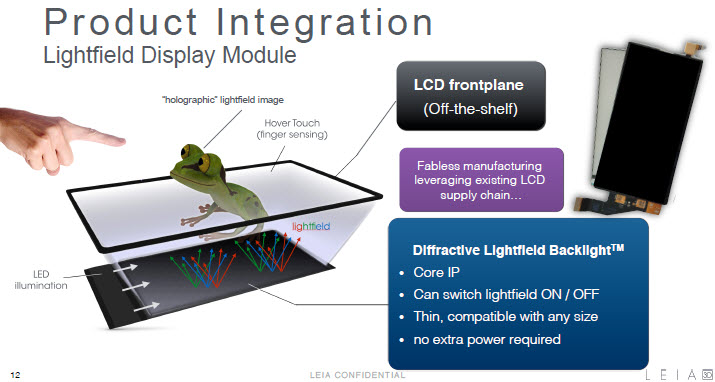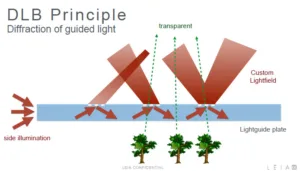David Fattal is the founder and CEO from Leia, which is a spin-off from HP work in Palo Alto which can create a switchable light field display from any mobile device. The company supplies technology but alse sees itself as a platform supplier for content as having a display is pointless without content.
Diffractive lightfield backlighting can be used to control very precisely the light coming from the backlight. LCD is the right choice as an imager for this application.
There is a difficulty is getting 3D information from a flat surface, Fattal said. But interactive holographic screens can be used for example, as HUDs in a car – that keep an arrow aligned with a road if you put a directional indicator, as an application.
In VR focus /vergence conflict is an issue (as discussed a lot in light field display developments at the SID). Privacy screens are also an important application for displays such as the one from Leia where you can direct the light from the display. You can also use it for multi-view displays e.g. in a car to hide a particular view from the driver or passenger.
In a regular flat display, the rays should all be the same in each direction. Light field switching reduces the resolution of the display, but Leia can switch between the two modes – i.e. it can operate in light field mode at low resolution or regular mode in high resolution. Previously, displays with depth used parallax barriers or lenticular technology. Parallax barriers work OK, but reduce the brightness and add cost for the extra layer. Lenticulars solve the problem of brightness, but there is too much crosstalk for good image quality.
Leia claims to be as clean in image quality as parallax barriers but as bright as lenticular. The development of the display was shown in the prestigious ‘Nature’ journal.
The system uses diffraction and light can be output in any direction – it can even be split in two different ways. If lit in one way the diffraction comes into play, but if illuminated in another way, it is completely transparent.

If you double the number of LEDs you can illuminate one way like a regular LED-backlit LCD, but in the other way, you can have a diffractive and light field/ dual display.
It is easier to scale resolution for LCD than for OLED, Fattal said and the pixel density of OLED is limited. Fattal wants to go to 8K, 12K or even 16K resolution – for Leia, more pixels is better until you get to the limit of diffraction.
The company has a Unity plug-in to create content suitable for its displays from any Unity 3D content and the firm also has a cloud service to create multi-views from stereo 3D content.
At the end of year, Leia will launch with a French company and also in Israel. It had Series A funding three years ago and is raising series B funding. It has centres in Silicon Valley and China.
The long term plan for the company is to be purely an ip provider.
Analyst Comment
In questions, Fattal confirmed that the Leia system depends on edge-lit displays, rather than direct lit. (BR)

